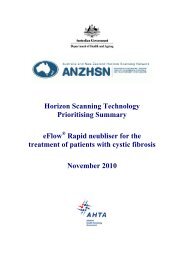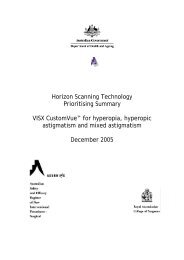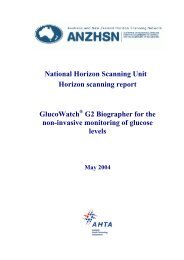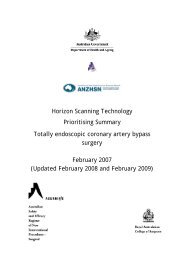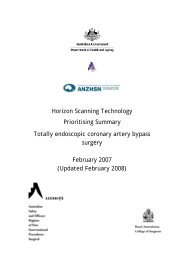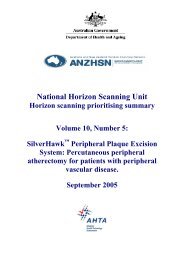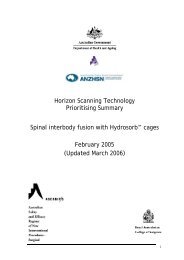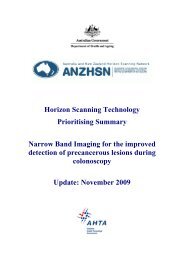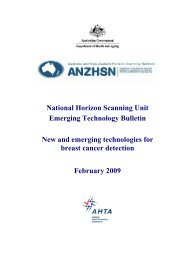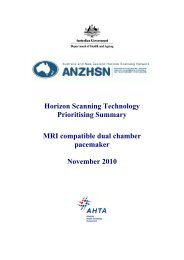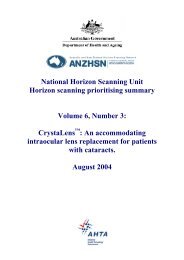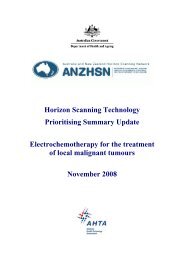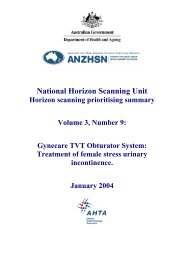Horizon Scanning Technology - the Australia and New Zealand ...
Horizon Scanning Technology - the Australia and New Zealand ...
Horizon Scanning Technology - the Australia and New Zealand ...
You also want an ePaper? Increase the reach of your titles
YUMPU automatically turns print PDFs into web optimized ePapers that Google loves.
National <strong>Horizon</strong> <strong>Scanning</strong> Unit<strong>Horizon</strong> scanning prioritising summaryVolume 12, Number 6:Telemedicine for <strong>the</strong> implementation ofstroke <strong>the</strong>rapy for patients in rural <strong>and</strong>remote areas.March 2006
© Commonwealth of <strong>Australia</strong> 2006[add ISSN][add Publications Approval Number]This work is copyright. You may download, display, print <strong>and</strong> reproduce this material inunaltered form only (retaining this notice) for your personal, non-commercial use or usewithin your organisation. Apart from any use as permitted under <strong>the</strong> Copyright Act 1968, allo<strong>the</strong>r rights are reserved. Requests <strong>and</strong> inquiries concerning reproduction <strong>and</strong> rights should beaddressed to Commonwealth Copyright Administration, Attorney General’s Department,Robert Garran Offices, National Circuit, Canberra ACT 2600 or posted athttp://www.ag.gov.au/ccaElectronic copies can be obtained from http://www.horizonscanning.gov.auEnquiries about <strong>the</strong> content of this summary should be directed to:HealthPACT SecretariatDepartment of Health <strong>and</strong> AgeingMDP 106GPO Box 9848Canberra ACT 2606AUSTRALIADISCLAIMER: This summary is based on information available at <strong>the</strong> time of research <strong>and</strong>cannot be expected to cover any developments arising from subsequent improvements tohealth technologies. This summary is based on a limited literature search <strong>and</strong> is not adefinitive statement on <strong>the</strong> safety, effectiveness or cost-effectiveness of <strong>the</strong> health technologycovered.The Commonwealth does not guarantee <strong>the</strong> accuracy, currency or completeness of <strong>the</strong>information in this summary. This summary is not intended to be used as medical advice <strong>and</strong>it is not intended to be used to diagnose, treat, cure or prevent any disease, nor should it beused for <strong>the</strong>rapeutic purposes or as a substitute for a health professional's advice. TheCommonwealth does not accept any liability for any injury, loss or damage incurred by use ofor reliance on <strong>the</strong> information.The production of this <strong>Horizon</strong> scanning prioritising summary was overseen by <strong>the</strong> HealthPolicy Advisory Committee on <strong>Technology</strong> (HealthPACT), a sub-committee of <strong>the</strong> MedicalServices Advisory Committee (MSAC). HealthPACT comprises representatives from healthdepartments in all states <strong>and</strong> territories, <strong>the</strong> <strong>Australia</strong> <strong>and</strong> <strong>New</strong> Zeal<strong>and</strong> governments; MSAC<strong>and</strong> ASERNIP-S. The <strong>Australia</strong>n Health Ministers’ Advisory Council (AHMAC) supportsHealthPACT through funding.This <strong>Horizon</strong> scanning prioritising summary was prepared by Linda Mundy, Janet Hiller <strong>and</strong>Tracy Merlin from <strong>the</strong> National <strong>Horizon</strong> <strong>Scanning</strong> Unit, Adelaide Health <strong>Technology</strong>Assessment, Department of Public Health, Mail Drop 511, University of Adelaide, South<strong>Australia</strong>, 5005.
Treatment of ischaemic stroke focuses on ei<strong>the</strong>r re-establishing normal blood flow to <strong>the</strong>ischaemic area <strong>and</strong>/or to block <strong>the</strong> mediators of ischaemic injury. Prompt treatment with athrombolytic drug such as tissue plasminogen activator (tPA), dissolves <strong>the</strong> obstructing blood clotrestoring blood flow before major brain damage has occurred (Wardlaw et al 2003; Mohammadet al 2004). A Cochrane review reported that for patients treated within three hours of symptomonset, thrombolysis appeared effective in reducing death or dependency (OR 1 0.66, 95% CI 1.15,1.53) (Wardlaw et al 2003).Although <strong>the</strong> United States Food <strong>and</strong> Drug Administration approved <strong>the</strong> use of tPA for treatmentof acute ischaemic stroke within three hours of symptom onset in 1995, uptake of this treatmentpractice has been slow. The <strong>New</strong> Zeal<strong>and</strong> Guidelines for <strong>the</strong> Management of Stroke recommendthat tPA be given to eligible patients but only by clinicians with expertise in <strong>the</strong> assessment <strong>and</strong>management of people with acute ischaemic stroke working in specialist centres. Currently in<strong>New</strong> Zeal<strong>and</strong> thrombolysis with tPA is only offered as st<strong>and</strong>ard treatment at Auckl<strong>and</strong> <strong>and</strong>Christchurch Hospitals (Barber & Gommans 2005; Fink 2005). In <strong>Australia</strong>, tPA was licences foruse in 2003 but is not widely used (personal communication, Department of Neurology, RoyalMelbourne Hospital, February 2006). The National Stroke Foundation of <strong>Australia</strong> recommendthat tPA be administered in stroke units with experience in its use (National Stroke Foundation2003).Appropriate administration of tPA requires that patients recognise that <strong>the</strong>y are having a stroke,get transported to a medical facility, have <strong>the</strong> diagnosis confirmed clinically <strong>and</strong> receive a brainscan to eliminate haemorrhagic stroke within three hours (Barber & Gommans 2005). In ruralareas, <strong>the</strong> distances necessary to travel to treatment centres along with a lack of consulting strokespecialists able to evaluate <strong>the</strong> patient <strong>and</strong> administer <strong>the</strong> appropriate <strong>the</strong>rapy, may prevent <strong>the</strong>prompt administration of tPA <strong>the</strong>rapy within <strong>the</strong> required timeframe. In <strong>New</strong> Zeal<strong>and</strong> in 2001,only five out of 41 hospitals admitting stroke patients had identified stroke specialists on <strong>the</strong>irstaff. A recent <strong>Australia</strong>n study found considerable variation in stroke care practices inmetropolitan teaching hospitals <strong>and</strong> no published data on stroke care practices in regional<strong>Australia</strong>. Differences in stroke care management in regional areas might be expected on <strong>the</strong>basis of different levels of resources <strong>and</strong> access to specialist expertise in stroke management(Read & Levy 2005)Telemedicine has been designed to make available a means of emergency patient evaluationwhich can be utilised to provide specialised stroke treatment to patients in rural <strong>and</strong> remote areas.Telemedicine employs <strong>the</strong> use of an interactive two-way audio-video system between hospitalswithout on-site stroke expertise <strong>and</strong> a stroke specialist. Patient assessment - history, neurologicexamination <strong>and</strong> computed tomography of <strong>the</strong> head, are all able to be reviewed by <strong>the</strong> strokespecialist using telemedicine, who is able to guide <strong>the</strong> local physician throughout <strong>the</strong> processincluding administration of treatments such as tPA. The primary benefit of telemedicine for acutestroke is <strong>the</strong> provision of speciality resources not available in regional hospitals (LaMonte et al2003).CLINICAL NEED AND BURDEN OF DISEASEStroke is a significant health problem in <strong>Australia</strong> <strong>and</strong> <strong>New</strong> Zeal<strong>and</strong>, which mainly affects olderindividuals, with rates of stroke increasingly markedly in people aged over 65 years. In <strong>Australia</strong>,approximately 346,700 had experienced a stroke at same stage in <strong>the</strong>ir lives in 2003. Each year1 OR = odds ratio2
<strong>the</strong>re are approxiamtely 40-48,000 stroke events among <strong>Australia</strong>ns. Nearly seven per cent of alldeaths in <strong>Australia</strong> are caused by stroke, with 9,006 deaths from stroke in 2003. During <strong>the</strong> sameperiod approximately 282,600 <strong>Australia</strong>ns with stroke had a disability <strong>and</strong> in 146,400 of <strong>the</strong>seindividuals <strong>the</strong> disability resulted from <strong>the</strong>ir stroke (Senes 2006).In <strong>New</strong> Zeal<strong>and</strong> during 2003-03, <strong>the</strong> prevalence of stroke was 2.1 per cent (95% CI 1.8, 2.4),which corresponds to one in 48 adults having been diagnosed with stroke at some stage in <strong>the</strong>irlives (Ministry of Health 2004).In <strong>Australia</strong> during <strong>the</strong> period 2003-04, <strong>the</strong>re were 40,791 hospital separations forcerebrovascular diseases (ICD 10 coded I60-I69), each involved an average stay of 10.5 days(AIHW 2006). In <strong>New</strong> Zeal<strong>and</strong> during 2001-02 <strong>the</strong>re were 8,787 public hospital separations forcerebrovascular diseases (ICD 10 coded I60-I69), with a mean stay of 43.1 days (<strong>New</strong> Zeal<strong>and</strong>Health Information Service, Ministry of Health).DIFFUSIONAlthough telemedicine is utilised in some clinical areas, to <strong>the</strong> knowledge of <strong>the</strong> Evaluators, it isnot used in <strong>the</strong> diagnosis <strong>and</strong> treatment of stroke patients in <strong>Australia</strong>. The Department ofNeurology in <strong>the</strong> Royal Melbourne Hospital has expressed an interest in using this technology if<strong>the</strong>y had <strong>the</strong> platform (personal communication, Department of Neurology, Royal MelbourneHospital, February 2006).COMPARATORSIn <strong>the</strong> absence of a telemedicine option, treatment of stroke patients should be conductedaccording to <strong>the</strong> recommended National Stroke Foundation Guidelines. Appropriate diagnosis ofstroke <strong>and</strong> immediate referral to a stroke team is important to minimise <strong>the</strong> risk of complicationsin <strong>the</strong> early stages of stroke, <strong>the</strong>refore patients should be triaged <strong>and</strong> responded to in anappropriate manner by emergency or medical staff. However, as <strong>the</strong>se options (CT scan <strong>and</strong>neurologic examination) require <strong>the</strong> interpretation of a specialist, in <strong>the</strong>ir absence appropriatetreatment would include general stroke management including oxygen supplementation forhypoxic patients <strong>and</strong> administration of aspirin if an ischaemic ra<strong>the</strong>r than a haemorrhagic stroke isdiagnosed (National Stroke Foundation 2003).EFFECTIVENESS AND SAFETY ISSUESIn <strong>the</strong> study by Audebert et al (2005), 356 patients presented to <strong>the</strong> emergency departments ofregional hospitals in Bavaria (level IV Diagnostic evidence). Patients were assessed viatelemedicine by specialists working in ei<strong>the</strong>r one of two hospitals which had comprehensivestroke care centres. Mean delay between onset of symptoms <strong>and</strong> hospital admission was 65 ± 25minutes <strong>and</strong> <strong>the</strong> mean time from door-to-needle was 76 ± 24 minutes. The mean time to treatment(administration of tPA) was 141 ± 27 minutes. The average time of <strong>the</strong> teleconsultation was 15.6minutes, with a st<strong>and</strong>ard deviation of 8.2 minutes. Of <strong>the</strong> patients assessed, 106 patients wereeligible to receive thrombolysis with tPA. Of <strong>the</strong> patients excluded from tPA treatment, <strong>the</strong> threehour treatment time window was exceeded before (n=23) or during (n=10) teleconsultation.Audebert et al (2005) et al reported an in-hospital mortality of rate of 10.4% <strong>and</strong> mortality withinseven days of 5.7 per cent. In-hospital mortality from strokes in hospitals within <strong>the</strong> samecommunity, which did not have access to telemedicine, was reported to be 24.1%. This rate wasstatistically higher when compared to <strong>the</strong> rate of hospitals participating in <strong>the</strong> telemedicine trial(p=0.02). Follow-up CT scans were performed after a median of 21 hours administration of tPA3
<strong>and</strong> a haemorrhage was detected 27 patients (25%). Of <strong>the</strong>se nine patients had a symptomaticbleed <strong>and</strong> three clinically deteriorated with haemorrhagic complications.Hess et al (2005) reported <strong>the</strong> results of a rural hospital telestroke network in Georgia, UnitedStates (level IV Diagnostic evidence). The network consisted of eight hospitals, only one ofwhich had formalised acute stroke care guidelines. During <strong>the</strong> study 194 acute strokeconsultations presented to <strong>the</strong> emergency departments <strong>and</strong> after telemedicine assessment by <strong>the</strong>stroke consultant, a decision to treat 30 of <strong>the</strong>se patients with tPA was made. The mean onset ofsymptoms to treatment time (OTT) was 122 minutes with <strong>the</strong> majority of patients (60%) beingtreated within two hours. CT imaging within 36 hours of tPA administration revealed nointracerebral haemorrhages <strong>and</strong> a decrease in <strong>the</strong> NIHSS 2 of ≥4 points was noted in 18/30 (60%)of patients within 24 hours. The in-hospital mortality rate was 2/30 (7%). Twenty-nine patientspresented to <strong>the</strong> emergency department beyond <strong>the</strong> three hour treatment time window. To assess<strong>the</strong> progress <strong>and</strong> improvement of <strong>the</strong> stroke network, <strong>the</strong> authors compared <strong>the</strong> OTT of <strong>the</strong> first10 to <strong>the</strong> last 20 patients. The mean OTT was reduced from 143 to 111 minutes (t=2.61,p=0.014). Two o<strong>the</strong>r papers reported on <strong>the</strong> initial stages of this project (Wang et al 2003; Wanget al 2003).A retrospective review of 50 consultations by an acute stroke specialist, delivered to a tertiaryhospital in Maryl<strong>and</strong>, United States from community hospital emergency departments wasconducted by LaMonte et al (2003). This study compared telemedicine consultations withtraditional telephone consultations (level IV Diagnostic evidence). Telemedicine was utilised in23/50 (46%) of cases. Of <strong>the</strong>se attempted telemedicine links, two were aborted due to technicaldifficulties. On two occasions, temporary phone wire problems caused problems in initiating <strong>the</strong>computer link, however a telephone consultation was ongoing while <strong>the</strong> telemedicine connectionwas re-established. A stuttering transmission occurred once but did not impede <strong>the</strong> consultation.COST IMPACTThere is currently no cost-effectiveness data or simple costing studies for <strong>the</strong> use of telemedicineto diagnose <strong>and</strong> treat stroke patients in remote or regional areas of <strong>Australia</strong> <strong>and</strong> <strong>New</strong> Zeal<strong>and</strong>. Asystematic review on <strong>the</strong> cost-effectiveness of telemedicine concluded that <strong>the</strong>re was goodevidence to suggest that telemedicine was a cost-effective means of delivering health care,although only 7/24 (29%) studies included in <strong>the</strong> review attempted to investigate <strong>the</strong> level ofutilisation that would be needed for telemedicine services to compare favourably withtraditionally organised health care. In addition most studies included equated benefits with costsavingswith no analysis of changes in benefit to patients (Whitten et al 2002).The study by Audebert et al (2005) reported that a 24-hour, on-dem<strong>and</strong> telemedicine servicestaffed by stroke experts would cost €300,000 per year. They calculated savings of between€3,200 <strong>and</strong> €4,200 per thrombolysis <strong>and</strong> with an absolute increase in <strong>the</strong> number of tPAtreatments (n=76) within one year, reductions in subsequent costs would be between €243,200<strong>and</strong> €319,200. After <strong>the</strong> subtraction of <strong>the</strong> teleconsultation expenses, <strong>the</strong> net expense would varybetween €56,800 <strong>and</strong> – €19,200, meaning that <strong>the</strong> service is cost-effective only with regard toconsultations for possible thrombolyses.The technology <strong>and</strong> equipment required for telemedicine may already be available in institutionsfor o<strong>the</strong>r functions. Basic requirements are equipment to capture <strong>the</strong> clinical information at eachsite, telecommunication links to transmit <strong>the</strong> information <strong>and</strong> equipment to display <strong>the</strong>2 NIHSS = National Institutes of Health Stroke Score4
information at each site. These requirements will vary according to <strong>the</strong> type <strong>and</strong> complexity of<strong>the</strong> information to be transmitted, <strong>the</strong> quantity of information to be transmitted <strong>and</strong> securityrequirements of <strong>the</strong> transmitted data. In addition, training personnel in <strong>the</strong> use of <strong>the</strong> equipmentwould be required (Harnett 2006).In <strong>Australia</strong>, expenditure for cerebrovascular disease amounted to $896 million in 2000–01,which is 1.8% of total health system expenditure. Aged care homes accounted for half of <strong>the</strong>funds allocated to cerebrovascular disease <strong>and</strong> hospitals accounted for 40% (Senes 2006). It islikely that telemedicine for <strong>the</strong> detection of stroke may provide cost-savings in <strong>the</strong>se areas if itenables <strong>the</strong> administration of tPA to a larger proportion of patients, reducing <strong>the</strong> morbidity <strong>and</strong>mortality associated with stroke.ETHICAL, CULTURAL OR RELIGIOUS CONSIDERATIONSCurrently people living in rural <strong>and</strong> regional areas of <strong>Australia</strong> <strong>and</strong> <strong>New</strong> Zeal<strong>and</strong> do not haveaccess to stroke specialists in <strong>the</strong>ir health care settings. Telemedicine for <strong>the</strong> diagnosis of strokewould increase access to neurological specialists for <strong>the</strong>se communities <strong>and</strong> may result in betterhealth outcomes <strong>and</strong> quality of life for stroke patients.OTHER ISSUESNo issues were identified/raised in <strong>the</strong> sources examined.CONCLUSION:The evidence for <strong>the</strong> effectiveness of telemedicine for <strong>the</strong> early detection of acute ischaemicstroke, followed by prompt treatment with tissue plasminogen activator is limited. However, <strong>the</strong>reis a good evidence base for successful outcomes for stroke patients when <strong>the</strong>y are treated withtPA.HEALTHPACT ACTION:This technology is part of an existing communication network in <strong>the</strong> <strong>Australia</strong>n health caresystem,<strong>the</strong>refore it is recommended that this technology be archived.SOURCES OF FURTHER INFORMATION:AIHW (2006). National Hospital Morbidity Database [Internet]. <strong>Australia</strong>n Institute of Health<strong>and</strong> Welfare. Available from: http://www.aihw.gov.au/cognos/cgiin/ppdscgi.exe?DC=Q&E=/AHS/principaldiagnosis0304[Accessed 24th January 2006].AIHW <strong>and</strong> NHF (2004). Heart, stroke <strong>and</strong> vascular diseases - <strong>Australia</strong>n facts 2004, <strong>Australia</strong>nInstitute of Health <strong>and</strong> Welfare <strong>and</strong> National Heart Foundation of <strong>Australia</strong>, Canberra.Audebert, H. J., Kukla, C. et al (2005). 'Telemedicine for safe <strong>and</strong> extended use of thrombolysisin stroke: <strong>the</strong> Telemedic Pilot Project for Integrative Stroke Care (TEMPiS) in Bavaria', Stroke,36 (2), 287-291.Barber, A. & Gommans, J. (2005). 'Tissue plasminogen activator approved for stroke', N Z Med J,118 (1214), U1432.Crome, O. & Bahr, M. (2003). 'Editorial comment--Remote evaluation of acute ischemic stroke: areliable tool to extend tissue plasminogen activator use to community <strong>and</strong> rural stroke patients?'Stroke, 34 (10), e191-192.5
Fink, J. (2005). 'Twelve-month experience of acute stroke thrombolysis in Christchurch, <strong>New</strong>Zeal<strong>and</strong>: emergency department screening <strong>and</strong> acute stroke service treatment', N Z Med J, 118(1214), U1430.Harnett, B. (2006). 'Telemedicine systems <strong>and</strong> telecommunications', J Telemed Telecare, 12 (1),4-15.Hess, D. C., Wang, S. et al (2005). 'REACH: clinical feasibility of a rural telestroke network',Stroke, 36 (9), 2018-2020.LaMonte, M. P., Bahouth, M. N. et al (2003). 'Telemedicine for acute stroke: triumphs <strong>and</strong>pitfalls', Stroke, 34 (3), 725-728.Ministry of Health (2004). A Portrait of Health: Key results of <strong>the</strong> 2002/03 <strong>New</strong> Zeal<strong>and</strong> HealthSurvey, Ministry of Health, Wellington.Mohammad, Y. M., Divani, A. A. et al (2004). 'Acute treatment for ischemic stroke in 2004',Emerg Radiol, 11 (2), 83-86.National Stroke Foundation (2003). Clinical Guidelines for <strong>the</strong> Management of Acute Stroke,National Stroke Foundation.Read, S. J. & Levy, J. (2005). 'Differences in stroke care practices between regional <strong>and</strong>metropolitan hospitals', Intern Med J, 35 (8), 447-450.Schwamm, L. H., Rosenthal, E. S. et al (2004). 'Virtual TeleStroke support for <strong>the</strong> emergencydepartment evaluation of acute stroke', Acad Emerg Med, 11 (11), 1193-1197.Senes, S. (2006). How we manage stroke, <strong>Australia</strong>n Institute of Health <strong>and</strong> Welfare, Canberra.Szoeke, C. E., Parsons, M. W. et al (2003). 'Acute stroke thrombolysis with intravenous tissueplasminogen activator in an <strong>Australia</strong>n tertiary hospital', Med J Aust, 178 (7), 324-328.Wang, S., Gross, H. et al (2004). 'Remote evaluation of acute ischemic stroke in rural communityhospitals in Georgia', Stroke, 35 (7), 1763-1768.Wang, S., Lee, S. B. et al (2003). 'Remote evaluation of acute ischemic stroke: reliability ofNational Institutes of Health Stroke Scale via telestroke', Stroke, 34 (10), e188-191.Wardlaw, J. M., Zoppo, G. et al (2003). 'Thrombolysis for acute ischaemic stroke', CochraneDatabase Syst Rev, (3), CD000213.Whitten, P. S., Mair, F. S. et al (2002). 'Systematic review of cost effectiveness studies oftelemedicine interventions', BMJ, 324 (7351), 1434-1437.LIST OF STUDIES INCLUDEDTotal number of studiesLevel IV Diagnostic evidence 3SEARCH CRITERIA TO BE USED:Cerebrovascular Accident/diagnosis/*drug <strong>the</strong>rapy*Emergency Service, HospitalHospitals, CommunityHospitals, Rural*Remote Consultation*Rural Population*Thrombolytic TherapyTissue Plasminogen Activator/*<strong>the</strong>rapeutic useBrain Ischemia/complications/*diagnosisTelemedicine/instrumentation/*methods6



